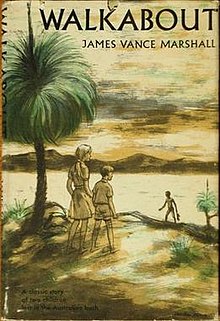Walkabout (novel)
 First hardcover edition (1959, Doubleday & Co.) | |
| Author | James Vance Marshall |
|---|---|
| Original title | The Children |
| Language | English |
| Genre | Survival |
| Published | Michael Joseph, 1959 (as The Children) |
| Publication place | Australia |
| Media type | Book |
| Pages | 125 |
| OCLC | 11073830 |
Walkabout is a novel written by James Vance Marshall (a pseudonym for Donald G. Payne), first published in 1959 as The Children.[1] It is about two children, a teenage sister and her younger brother, who get lost in the Australian Outback and are helped by an Indigenous Australian teenage boy on his walkabout. A film based on the book, with the same title came out in 1971, but deviated from the original plot.
Plot summary
Two American siblings, Peter and Mary, are stranded by a gully in the Australian outback following a plane crash. Peter says they should seek out their uncle, who lives in Adelaide; Mary agrees and they begin walking across the desert, but they do not know that it is across the other side. The next day, they keep walking and searching for food but their efforts are in vain. Suddenly, an Aboriginal teen of about Mary's age (referred to within the text as the "bush boy") appears and startles them, mostly due to his nudity. Hoping to make him leave, Mary glares at him. This proves ineffective. Hoping to find out about the strangers, he inspects both of them but finds nothing of interest, so he leaves.
Peter and Mary, shocked at potentially losing their only hope for survival, follow him. Peter attempts to communicate with him through gestures of eating and drinking, and the bush boy quickly comes to comprehend their plight. He indicates that they should follow him, which they do. He arrives at a waterhole where the children drink their fill. Then, the bush boy prepares food for the hungry children. After this, he begins to lead the children to the next waterhole. The bush boy misinterprets Mary's look of disgust at his nakedness as her having seen the spirit of death, and falls into a mental euthanasia.
By the time the trio arrive at the next waterhole, the symptoms of the flu Peter has unwittingly passed on to the bush boy are beginning to show in the latter. He begins to worry and decides he must tell the children he needs a burial platform to keep bad spirits from his body and to keep the snakes from "molesting his body" after his death. Peter is gathering firewood, and so to avoid interrupting a man at work, the bush boy seeks Mary, who is bathing. The bush boy doesn't see a bath as something private; he arrives at the pool and Mary is terrified, threatening the bush boy with snarls and a rock. He is confused and becomes depressed, believing that he will not have his burial platform.
Mary goes to Peter and tells him to leave with her, but Peter is concerned about the bush boy and so Mary is forced to stay. Peter tells her that the bush boy is very sick; he realizes that the bush boy could die, while Mary refuses to believe that the flu could be fatal, not understanding the native boy's fear of the Spirit of Death he believes she saw in him. Soon, Mary goes to investigate. Finally, she acknowledges that he is actually dying and forgives him. She lays his head in her lap and he touches her hair. Mary realizes that they are not so different, despite his appearance and language. He dies later in the night. They bury him and leave for the food and water-filled valley Peter was told about by the bush boy before he died.
They stop at a pool where they eat some yabbies, observe platypus and leave. In a valley rich in water, food, and wildlife, they survive for many days with the skills learned from the bush boy. During that time, Mary's dress is destroyed. They also discover some wet clay which they use to draw pictures: Peter draws nature while Mary draws stylish women and her dream house. Eventually, the children see smoke and come across a group of Aboriginal swimmers. One of the swimmers, a man, sees the drawings. His son owns a "warrigal", or pet dog, which serves as a link between the boy and Peter. The father sees Mary's dream house and realizes Mary and Peter seek civilization. In a wide variety of gestures and drawings, he tells the children that there is a house like that across the hills and demonstrates how to reach there. The overjoyed children thank him and begin their trek back to civilization.
Reception
It is by far Vance's most popular work,[2] due in large part to the success of the related film. Reviewers have praised Walkabout for its detailed and accurate descriptions of the Australian environment.[3]
External links
References
- ^ "The Children". OCLC Worldcat. Retrieved 1 April 2014.
- ^ "White Out (Book Review)". Publisher's Weekly. 247 (43): 57. 23 October 2000.
- ^ "Walkabout". Atlantic Monthly. 309 (3): 94. April 2012.
